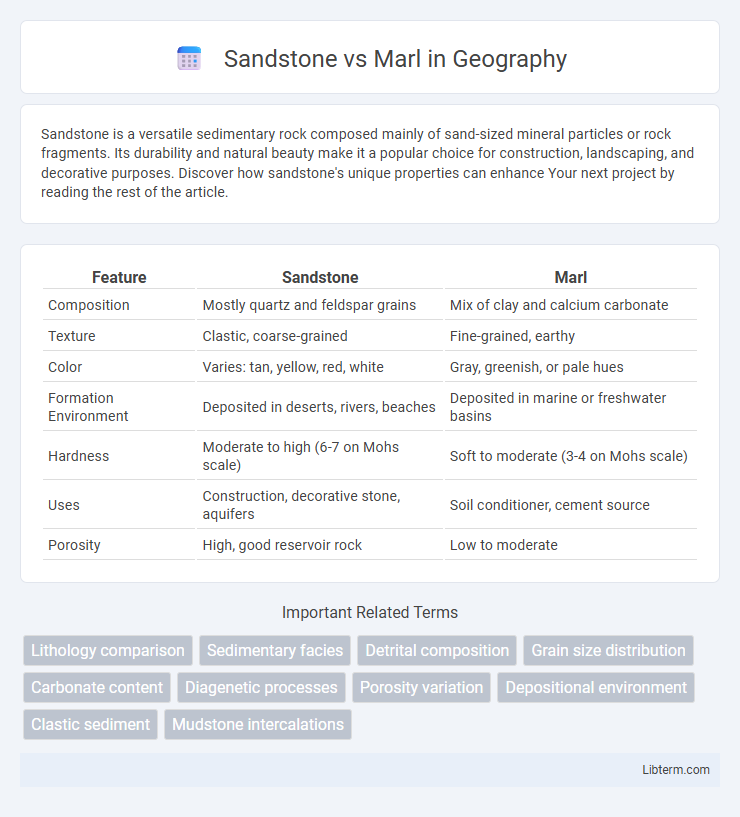Sandstone is a versatile sedimentary rock composed mainly of sand-sized mineral particles or rock fragments. Its durability and natural beauty make it a popular choice for construction, landscaping, and decorative purposes. Discover how sandstone's unique properties can enhance Your next project by reading the rest of the article.
Table of Comparison
| Feature | Sandstone | Marl |
|---|---|---|
| Composition | Mostly quartz and feldspar grains | Mix of clay and calcium carbonate |
| Texture | Clastic, coarse-grained | Fine-grained, earthy |
| Color | Varies: tan, yellow, red, white | Gray, greenish, or pale hues |
| Formation Environment | Deposited in deserts, rivers, beaches | Deposited in marine or freshwater basins |
| Hardness | Moderate to high (6-7 on Mohs scale) | Soft to moderate (3-4 on Mohs scale) |
| Uses | Construction, decorative stone, aquifers | Soil conditioner, cement source |
| Porosity | High, good reservoir rock | Low to moderate |
Introduction to Sandstone and Marl
Sandstone is a clastic sedimentary rock composed mainly of sand-sized mineral particles or rock fragments, predominantly quartz and feldspar. Marl is a calcium carbonate-rich sedimentary rock or soil consisting of varying amounts of clay and silt, often formed in marine or freshwater environments. Both rocks play significant roles in geological studies, construction, and soil fertility assessment.
Geological Formation of Sandstone
Sandstone forms primarily through the sedimentation and lithification of sand-sized mineral particles, typically quartz, within depositional environments such as riverbeds, beaches, and deserts. Its porosity and grain size reflect the conditions of sediment transport and burial, often resulting in well-sorted, compacted layers that solidify over millions of years. This contrasts with marl, which is a calcium carbonate-rich sedimentary rock formed in lacustrine or marine settings with more fine-grained clay and silt components.
Geological Formation of Marl
Marl forms primarily from the accumulation of calcium carbonate-rich mud and silt in freshwater and marine environments, often linked to the gradual lithification of calcareous clay and lime-rich sediments. It differs from sandstone, which is composed mainly of sand-sized mineral particles or rock fragments cemented over time in more energetic depositional settings like rivers or beaches. Geological formations of marl are typically characterized by fine-grained, soft sediment layers that indicate low-energy depositional environments, often preserving fossils and organic material due to slower sedimentation rates.
Mineral Composition: Sandstone vs Marl
Sandstone primarily consists of quartz grains cemented by silica, calcite, or iron oxides, often containing feldspar and mica minerals, which contribute to its hardness and durability. Marl is a calcium carbonate-rich sedimentary rock containing varying amounts of clay, silt, and calcite, typically formed from marine or lacustrine deposits. The dominant mineralogy distinguishes sandstone's siliceous framework from marl's calcareous and clayey composition, affecting their porosity, permeability, and suitability for construction or agricultural use.
Physical Properties Comparison
Sandstone exhibits high porosity and permeability due to its granular texture and quartz composition, making it ideal for groundwater reservoirs, while marl, composed of clay and calcium carbonate, has lower permeability and higher plasticity. The density of sandstone typically ranges from 2.2 to 2.8 g/cm3, whereas marl is denser, often between 2.4 and 2.7 g/cm3, reflecting its mixed sediment composition. Sandstone's hardness, measured on the Mohs scale at around 6 to 7, surpasses marl's softer texture, which is often below 3, influencing their respective durability in construction and erosion resistance.
Common Uses of Sandstone and Marl
Sandstone is commonly used in construction for building facades, paving, and decorative stone due to its durability and aesthetic appeal. Marl finds frequent application in agriculture as a soil conditioner to improve pH and nutrient content, and in cement manufacturing as a source of calcium carbonate. Both materials serve as important geological resources, with sandstone favored for structural purposes and marl primarily utilized for soil improvement and industrial processes.
Environmental Durability and Weathering
Sandstone exhibits high environmental durability due to its dense, quartz-rich composition, making it highly resistant to weathering processes such as freeze-thaw cycles and chemical erosion. Marl, a calcium carbonate-rich sedimentary rock, is more susceptible to chemical weathering and dissolution under acidic conditions, which reduces its long-term stability in outdoor applications. The porosity and mineral content differences between sandstone and marl significantly influence their respective performance and lifespan in exposed environments.
Geographic Distribution and Occurrence
Sandstone predominantly occurs in continental environments such as river channels, deserts, and beaches and is widely distributed across North America, Europe, and parts of Asia, reflecting its formation from quartz and feldspar grains. Marl, a calcium carbonate-rich sedimentary rock, is frequently found in marine or lacustrine settings, especially in regions like the Mediterranean basin and the central United States where fine sediments accumulate in low-energy aquatic environments. The geographic distribution of sandstone aligns with tectonically active regions and sedimentary basins, whereas marl is more common in stable, shallow marine settings with abundant biological activity.
Advantages and Disadvantages
Sandstone offers high durability and excellent weather resistance, making it suitable for construction and decorative purposes, but it can be more expensive and prone to erosion in acidic environments. Marl, composed of clay and calcium carbonate, is more affordable and beneficial for agricultural soil improvement due to its nutrient content, though it lacks the structural strength of sandstone and may degrade under heavy moisture exposure. Choosing between sandstone and marl depends on balancing durability needs against cost and environmental conditions.
Conclusion: Choosing Between Sandstone and Marl
Sandstone offers durability and resistance to weathering, making it ideal for construction and decorative purposes in harsh environments. Marl, rich in calcium carbonate, enhances soil fertility and is preferred in agricultural applications and landscaping. Selecting between sandstone and marl depends on the specific project requirements, environmental conditions, and desired material properties.
Sandstone Infographic

 libterm.com
libterm.com